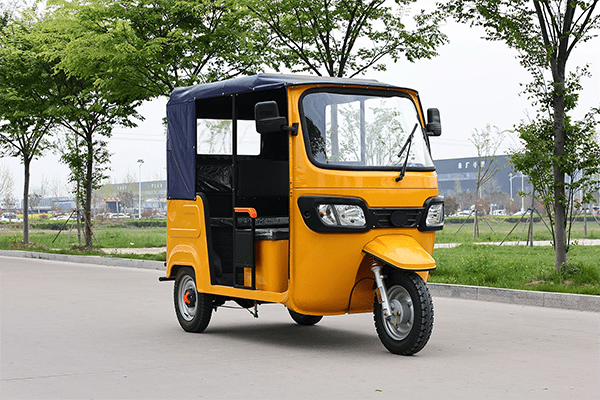Electric tricycles, or e-trikes, have become increasingly popular for personal transportation, especially among those seeking a stable and eco-friendly mode of travel. A key component of any electric tricycle is its motor, and choosing the right drive method can significantly affect performance, comfort, and overall riding experience. Two of the most common motor configurations for electric tricycles are the front hub motor and the rear gear motor. This article will explore the differences between these two drive methods to help you decide which one might be best for your needs.
Understanding Front Hub Motors
Front hub motors are located in the center of the front wheel of the tricycle. This type of motor is directly integrated into the wheel hub and provides propulsion by spinning the wheel from the front.
Advantages of Front Hub Motors:
- Simplicity and Cost: Front hub motors are generally simpler in design and easier to install compared to other types of motors. This simplicity often translates to a lower cost, making electric tricycles with front hub motors a more budget-friendly option.
- Balanced Weight Distribution: With the motor located at the front, the weight is more evenly distributed between the front and rear of the tricycle. This can lead to a more balanced ride, particularly when the battery and rider’s weight are centered or towards the back.
- All-Wheel Drive Potential: For those interested in extra traction, a front hub motor can effectively create an all-wheel-drive system when used in conjunction with a rear motor. This setup is especially beneficial for navigating slippery or uneven surfaces.
- Ease of Maintenance: Since the front hub motor is not integrated with the pedal drivetrain, it generally requires less maintenance and is easier to replace or repair.
Disadvantages of Front Hub Motors:
- Less Traction: The front wheel can sometimes slip or lose traction, especially on loose or wet surfaces, because most of the rider’s weight is on the rear wheels. This can make it more challenging to handle in certain conditions.
- Handling Differences: A front-heavy electric tricycle can feel different to steer, particularly for those used to rear-driven models. The motor’s torque can cause the handlebars to pull, which some riders might find unsettling.
Understanding Rear Gear Motors
Rear gear motors, as the name suggests, are located on the rear wheel of the tricycle. These motors are typically integrated into the rear axle and drive the wheel directly, providing propulsion from the back.
Advantages of Rear Gear Motors:
- Better Traction and Control: Rear gear motors provide better traction because the majority of the rider’s weight is over the rear wheels. This makes rear gear motors ideal for climbing hills and navigating rough terrain, where maintaining grip is essential.
- Enhanced Power and Efficiency: Rear gear motors are often more powerful and efficient compared to front hub motors. They can handle steeper inclines and heavier loads, making them suitable for those who plan to use their tricycle for carrying groceries, cargo, or even passengers.
- More Natural Riding Experience: With the motor driving the rear wheel, the riding experience feels more natural and akin to a traditional tricycle or bicycle. This is especially true when starting from a standstill or accelerating, as the push from the rear is smoother.
- Lower Center of Gravity: Rear gear motors help keep the center of gravity lower and further back, which can improve stability, especially when making sharp turns or navigating through busy streets.

Disadvantages of Rear Gear Motors:
- Complexity and Cost: Rear gear motors are generally more complex and can be more expensive than front hub motors. The installation process is more involved, particularly if the motor is integrated with the tricycle’s gearing system.
- Higher Maintenance Needs: Because rear gear motors are integrated with the drivetrain, they can require more maintenance. Components like chains, gears, and derailleurs may wear out faster due to the additional torque.
Choosing the Right Motor for Your Needs
When deciding between a front hub motor and a rear gear motor for your electric tricycle, it’s important to consider how and where you plan to use it.
- For Commuters and Casual Riders: If you’re looking for an affordable, low-maintenance electric tricycle for city commuting or casual riding, a front hub motor might be the best choice. It offers simplicity and sufficient power for flat or mildly hilly terrain.
- For Adventurous Riders and Heavy Loads: If you need more power for climbing hills, carrying heavy loads, or riding on uneven terrain, a rear gear motor could be more suitable. It provides better traction and a more natural riding experience, albeit at a higher cost and with potentially more maintenance.
- For All-Weather or Off-Road Use: Riders who frequently encounter wet or loose surfaces, or who want to take their tricycle off-road, might benefit from a rear gear motor due to its superior traction and handling capabilities.
Conclusion
Both front hub motors and rear gear motors have their unique advantages and disadvantages. The best choice for you will depend on your specific needs, budget, and riding conditions. By understanding the differences between these two motor types, you can make an informed decision and select the electric tricycle that best fits your lifestyle.
Post time: 08-24-2024





